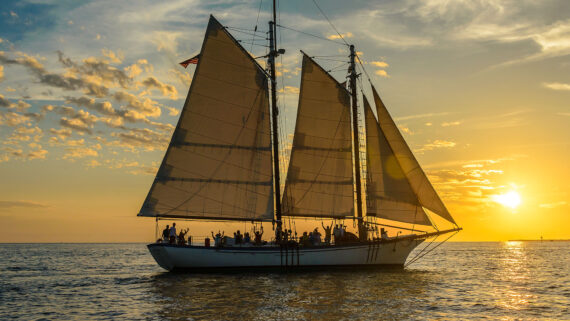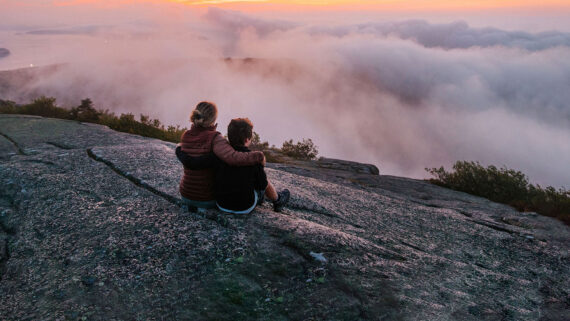
Cleanest Lakes in the US: Lake George, NY
When it comes to the cleanest lakes in the US, nothing is more pristine than Lake George, the largest body of water within New York State’s six-million-acre Adirondack Park. Here’s why its waters are so crystal clear – drinkable quality, in fact.
With crystalline waters ringed by majestic 4,000-foot mountains and peppered with 100-plus thickly-wooded islands, Lake George sure is pristine. But we don’t just mean that in a “picture-perfect” sense. “Pristine” is also what defines the physical makeup of the lake’s deep blue water itself.
In fact, out of the 479,950 lakes in the lower 48 states, Lake George is home to some of the purist waters. So much so, in summer of 2024, the 32-mile-long watershed was recognized by Travel + Leisure and a study conducted by A-Z Animals as being the number one cleanest lake in the US. Not number 10. Not number two. Of the top 10 cleanest lakes in the US, Lake George ranks number one. And that also makes it one of the cleanest lakes in NY state, too.
So, while the water quality is certainly a crowning feature on what’s long been nicknamed the “Queen of American Lakes,” what makes this water so crystal clear? It turns out, Lake George is a pretty special place.
HOW CLEAN IS LAKE GEORGE?

New York State rates Lake George’s water as Class AA-Special, the highest rating possible for water quality. This classification means the water is drinkable quality – and, in fact, many residents do indeed draw their water directly from the lake.
“Visitors regularly comment on the clarity of the water and how they can see through to the bottom,” says Tom Guay, general manager of The Sagamore Resort, an Opal Collection resort set on Lake George’s western edge. “They’re instantly surprised and impressed.”
WHY IS LAKE GEORGE WATER SO CLEAR?
Lake George in New York is considered one of the cleanest and clearest large lakes in the world due to these three key factors:
1. Its Unique Location Helps to Protect It
Key to Lake George’s water quality is the fact that it’s surrounded by constitutionally protected “Forever Wild” Forest Preserve. In fact, more than 90% of the watershed sits within natural forest land – specifically mountainous old-growth forests and dense wetlands. This not only limits the amount of pollution in the region, but the forest and mountain slopes themselves essentially act as a protective barrier to filter any sediment and slow runoff into the lake. When rain falls, the water seeps into the soil, where it is naturally purified before flowing into the lake.
Secondly, the lake is also fed by mountain streams that originate close to their source, making them less likely to carry contaminants. And with a depth of nearly 200 feet, this large volume of water helps to dilute any pollutants that may enter.

2. Locals Cares About This Lake – A Lot
Many locals who live in the Lake George region have adopted sustainable habits to reduce pollution, such as limiting the use of fertilizers, properly maintaining septic systems, and employing eco-friendly landscaping techniques. This is largely thanks to the Lake George Association (LGA), one of the oldest lake protection organizations in the US (founded in 1885), which actively engages citizens to raise awareness for maintaining the lake’s clear-water quality through education and hands-on programs. The lake is, after all, their most vital source of drinking water.
3. Water Quality Monitoring by The Jefferson Project
Despite Lake George being well-known as one of the clearest and cleanest large lakes in the world, its pristine waters still face threats, particularly: rising salinity levels affecting aquatic levels as a result of road salt de-icing; runoff from the surrounding landscape; and ecosystem threats from invasive species, like zebra mussels and Asian clams.
Which is where The Jefferson Project comes into the picture. Launched in 2013 as a collaboration between Rensselaer Polytechnic Institute (RPI), IBM Research, and the LGA, the mission of the project is to harness the power of big data to help an expansive team of scientists understand, in real-time, the state of Lake George’s watershed and how it’s changing at any given second. So how do you get that data? The Jefferson Project has installed an immaculate web of more than 500 lake sensors in 36 locations across the lake, on the lake bottom, on floating platforms, and in feeder streams – a state-of-the-art observational system unlike anything else in the world.
And with such information comes the power to forecast what could happen to the watershed if left unchecked. It’s like their very own crystal ball – the ability to look into the future…and, if necessary, course-correct with policy and programs before it’s too late.
WAYS TO ENJOY LAKE GEORGE’S PRISTINE WATERS
The crystalline waters of Lake George feature plenty of activities that are inviting to kayakers, swimmers, fishermen, and wildlife explorers, but a few of the favorites include the following:
The Morgan
Owned and operated by The Sagamore Resort, this replica nineteenth-century touring vessel takes guests on hour-and-a-half lake excursions, revealing a shoreline full of grand historic mansions, mountainous wilderness, and often-unexplored islands.
Lake George Kayak Company
A rentable canoe, SUP, or kayak from this Green Island-based watersports outfitter, located right near The Sagamore’s grounds, makes for a fun way to explore the 32-mile lake at your own pace.
Original Tiki Tours
A 16-passenger, thatch-covered tiki boat putters past iconic shoreline sights like Million Dollar Beach and The Sagamore Resort.
BEST WATERFRONT HOTEL ON LAKE GEORGE
The Sagamore Resort

Set on a private 70-acre island on the western shore of lower Lake George, The Sagamore Resort is a sprawling Victorian-era escape that has been welcoming visitors for more than 140 years. The 300-plus lakeside accommodations are vast and varied including traditional luxury guest rooms and suites in the main historic hotel; inviting lakeside lodges with modern kitchens and comfortable living rooms; bi-level suites housed in a nineteenth-century carriage house, and on-site private homes, like The First House and The Castle. As for what to do on-site, there’s award-winning dining, an 18-hole Donald Ross-designed golf course, a 10,000-square foot recreation center, and all spoils of that big beautiful lake from fishing to boating and beyond.




